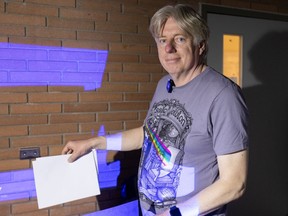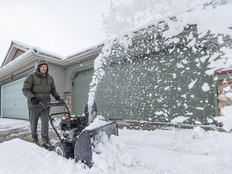How to make a simple pinhole camera to view the eclipse
All it takes is a few household items

Article content
People wanting to experience the solar eclipse on April 8 in a creative and safe way can do so by creating a pinhole camera.
Jeroen Stil, associate professor of astronomy at the University of Calgary, said there are a variety of ways to put together a pinhole camera. The simplest way is to use two pieces of white cardstock paper, aluminum foil, tape and a pin.
First, cut a one- to two-inch square or rectangular hole in the middle of one of the pieces of cardstock, and tape a piece of aluminum foil over the hole.
Flip over the paper and use a pin to poke a small hole in the aluminum foil. “One of the things that people do is spell their name or some kind of pattern using the pins,” said Stil.
Place the second piece of cardstock on the ground and hold the piece with aluminum foil above it, with the foil facing up. With the sun behind you, the projected image can be viewed on the card stock below.
A pinhole camera works because the small hole made with the pin acts like a tiny camera lens.
Light from the sun enters the pinhole, gets focused, and is then projected out of the other side of the hole. When the projected light reaches a surface, such as the second piece of paper, you can see the image that passed through the pinhole.

“People should resist the temptation to look directly at the sun — and not even through the hole; it will not help at all,” Stil said. “But if you make a pinhole camera and you look at the image of the sun projected through the hole on the white screen, you’re actually looking away from the sun at an object that is in daylight.”
The farther away from the second surface you hold the pinhole camera, the bigger the projected image will be.
“As long as you just look at the screen, where the little image of the sun is, you’ll be safe.
“It is actually a great talking point about science for kids, especially when you can make an image of the sun with such simple equipment.”






Postmedia is committed to maintaining a lively but civil forum for discussion. Please keep comments relevant and respectful. Comments may take up to an hour to appear on the site. You will receive an email if there is a reply to your comment, an update to a thread you follow or if a user you follow comments. Visit our Community Guidelines for more information.